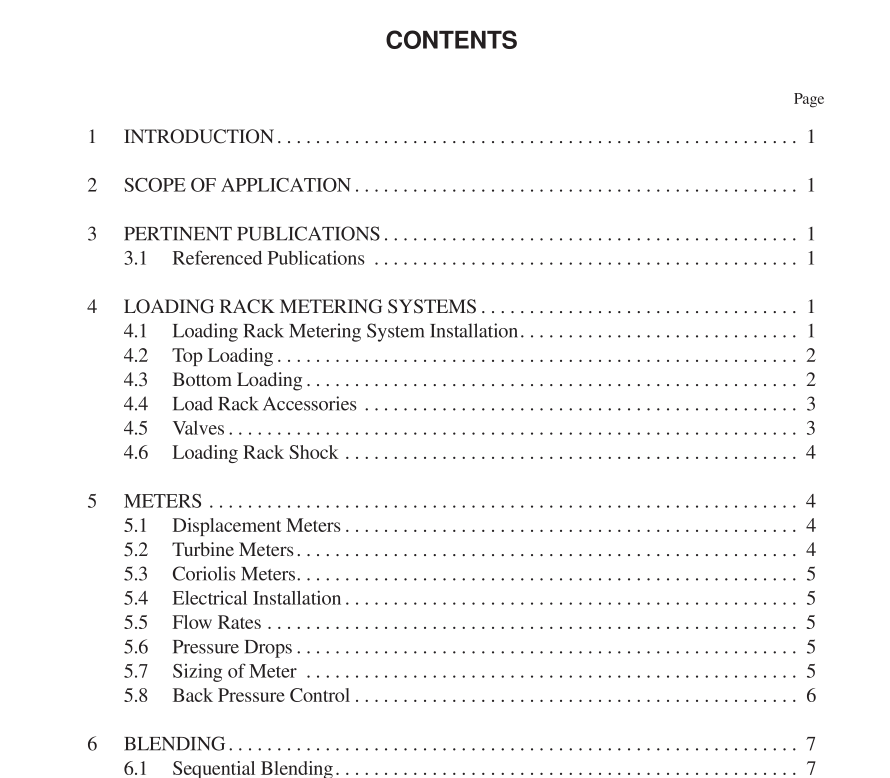API MPMS 6.2 pdf download

API MPMS 6.2 pdf download.Manual of Petroleum Measurement Standards Chapter 6—Metering Assemblies
5.1 DISPLACEMENT METERS
Displacement meters (API MPMS Ch. 5.2) will require some form of signal output, either mechanical or electronic. Note that whenever a meter with a manual calibrator mounted below the pulser is retrofitted with an electronic pulse output device, the calibrator must be removed. Displacement meters typically can be mounted either verti- cally or horizontally. Consult the manufacturer for proper ori- entation or issues of bearing load and wear. Displacement meters do not require flow conditioning. See Figure 3 for a typical installation.
5.2 TURBINE METERS
The performance of turbine meters (API MPMS Ch 5.3) is affected by liquid swirl and non-uniform velocity (laminar) profiles that are induced by upstream and downstream piping configurations, valves, pumps, joint misalignment, protruding gaskets, welding projections, additive injection points, ther- mowell or other obstructions. Flow conditioning shall be used to overcome swirl and non-uniform velocity profiles. Upstream flow conditioning requires the use of a flow condi- tioning plate, sufficient length of pipe, or a combination of straight pipe and straightening elements. Flow conditioning is required downstream of the meter; generally, five pipe diame- ters is recommended. A flow conditioning plate is a perforated plate or wafer that has a unique geometric pattern of holes or openings to pro- vide flow conditioning with a minimum use of space. Flow conditioning plates provide a uniform flow distribution with low turbulence intensity and are designed to eliminate swirl and produce a fully developed velocity flow profile. They function by greatly reducing the scale of turbulence into a large number of small disturbances, which coalesce and rap- idly diminish.The position, size and number of holes in the plate are designed to provide a uniform velocity profile. Any misalign- ment of the plate could cause errors in registration. Manufac- turers often design plates as an integral part of the turbine meter design to ensure alignment. Due to possible misalign- ment, caution is recommended for plates that bolt between flanges and are not integral to the turbine meter. Periodic inspection of the plate is necessary to prevent fouling, plug- ging or distortion. Any disturbance of the plate requires that the meter be re-proved.Perforated plates generally have a higher pressure drop than a tube bundle type. The amount of open area may vary by manufacturer, thus affecting pressure drop and flow rate. The effects on delivery rate must be considered when using plates. Plates can be used in different piping configurations. Meters with plates can be mounted either in the vertical or in horizontal piping. For loading racks, turbine meters may be mounted either vertically or horizontally; however, a downward flow to a ver- tically mounted meter is not recommended. In this case, the rotor will not be hydraulically balanced and will ride continu- ously on the downstream bearing, thus causing added wear and measurement errors. Turbine meters are more susceptible to problems arising from debris (see Figure 4).
5.3 CORIOLIS METERS
The sensor output signal from a Coriolis meter is not directly usable. The signals from the meter are interfaced with the integral signal processor where they are converted to a pulse output. Coriolis meters (API MPMS Ch 5.6) need to be mounted such that they remain liquid full. Any air in the sensing tubes will create errors in the measurement system. Consult with the manufacturer for specific installation requirements. Cori- olis meters do not require flow conditioning (see Figure 5). A means should be provided to isolate the liquid full meter under no-flow conditions for zeroing purposes, in accordance with the API MPMS Ch 5.6.









